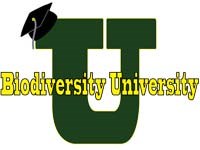
During Bioblitz, everyone had an opportunity to learn more about the importance of biodiversity in a variety of ways. Whether participating in a field survey, listening in on a scientist lecture, or talking with the park's many partners at the Convoy Point or Elliott Key basecamps, participants earned "credits" towards degrees in Biodiversity Awareness! Biodiversity University participants kept track of their learning on an Official Transcript. One box on the transcript was stamped for each credit received. Six stamps is all you needed to earn a B.B.A. (Bachelor of Biodiversity Awareness) diploma! Additional credits/stamps earned advanced degrees! To make sure everyone had a solid foundation, there were three required courses. These credits were earned by participating in hands-on activities at Convoy Point. School groups and individuals completed online activities at the National Geographic website to take care of their required courses before they arrived. With the required courses under their belt, they were only 3 credits away from earning a B.B.A (Bachelor of Biodiversity Awareness)! Credits could be earned in the following ways:
Upon returning their transcript to the Biodiversity University tent, staff checked it over and issue a printed diploma. Tree of Life Also located in the Biodiversity University tent was the "Tree of Life," a visual representation of the species count as it progressed. A large tree trunk with empty branches stood in one corner of the tent at the start of BioBlitz. Paper leaves were printed on several colors of paper. On each leaf was a space for the genus and species of an organism, along with a place for either its common name (if it has one) or the general group of animals it belongs to, such as sponge, bacterium, insect, etc. If the species was previously known in the park, it was assigned a green leaf (the majority of leaves). If it is a species that is new to the park, it was assigned a lime green leaf (a "new" leaf). Endangered and threatened species were assigned yellow leaves (getting ready to fall). There were several brown leaves on the floor, representing species that are now extinct. As species lists came in from the Science Tent, participants took an appropriately colored sheet, wrote the info on it, cut it out and punched a hole in the petiole so the leaf could be attached to the tree. As BioBlitz progressed, the tree filled out, and by the end was a visual representation of the species count. |
Last updated: December 21, 2017
